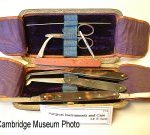Cambridge Collections
Mystery Creek

By Bernard Johnson ©
‘Mystery Creek’ is clearly a place with an intriguing past, and fortunately a classic local history source gives us the background to the name.
In ‘Plough of the Pakeha’ (1975) Eric Beer and Alwyn Gascoigne tell the story of Christian Hansen who was robbed in 1867.
He was a Waikato War veteran who, having a farm section on the main route from Hamilton via Ohaupo to Te Rore, was used to strangers asking the way, even at midnight. Two men entered his house by this subterfuge on 18 December, threatened him with a knife, and took his savings of 21 gold sovereigns.
Hansen reached for his loaded rifle, which one of the robbers grabbed and shot Hansen in the left wrist, whereupon the bandits fled with the money. In desperate pain the victim made his way to Orum’s Hotel two miles away where they sent for Dr Sam from the Cambridge Military Hospital.
Amputation was necessary so Hansen had to travel by dray and punt to the operating theatre. Regrettably there was insufficient chloroform for anaesthesia, which meant that Hansen had to bear the operation ‘manfully’. (They bred them tough in the pioneer days.)
The robbery was a mystery, presumably the work of an insider because Hansen had never disclosed the presence of his treasure. Greater mystery was added some months later when a settler, looking for a lost cow in the gully, found the decomposed corpse of a man. Investigators found that he had been strangled. They concluded that one of the thieves had murdered the other and taken off with the money, which was never found. Nor was the body ever identified.
These compounded elements led to the gully area becoming known as ‘Mystery Creek’ a name famous today for other events.
Postscript
Having read my confidently composed article on the origin of the name ‘Mystery Creek’, Eris smiled and said, “There are other versions you know”. She gave me several cuttings which bear this out, and I duly report as follows, in chronological order.
The Waikato Times on 19 October 1895 says that it was ‘so named from the number of people mystified in finding the proper crossing’.
The same article says that a soldier suddenly disappeared, never to be seen again, while crossing the gully in the early Maori disturbances.
On 17 February 1910, the Te Aroha Mail says that an old Cambridge resident recalls that a commissariat wagon disappeared over the bank of the creek, there being no road at the time. Two Irish soldiers saw it re-appear quickly, toiling up the steep bank opposite. ‘How did it do that?’ said one. ‘Divil the wan of me knows’, said the other, ”tis a mystery sure enough’.
By 22 July 1966 Eric Beer, co-author of ‘Plough of the Pakeha’, reported to the Cambridge Historical Society in great detail the account which I abbreviated in my above article. He said that while it is not known which of the many stories and unexplained events that took place in this locality was the certain origin of the name, he saw it was ‘obvious’ that the tale which he related ‘must be given credence as the real story’.
In a sort of Chinese Whispers, a local jet-boat driver, Lloyd Miller, told the Waikato Times on 3 July 1997 the story he gave to clients. It is very similar to that of Eric Beer’s. Lloyd said that two farmers were robbed, not one, and that about four months later the decomposing body was found. Legend had it that the robbers fought among themselves and one plunged to his death from a cliff into the gully.
Lloyd knew of other versions, about which he was less confident. One was that a murder was committed and the fugitive hid at Mystery Creek; a policeman sent to find him never returned. Another was that a mailman was robbed of his cargo, which was never found. Finally a saddled horse was found in the gully in the early days, but there was no trace of the rider.
So here we have half a dozen or so versions of how Mystery Creek may have got its name. By looking at the newspaper for December 1867 we are able to back the remarkable tale of Beer and Gascoigne (1975). Does anyone else have a version not mentioned above?
